Communities in rural Montana reach beyond agriculture
By Samuel Western
I’m in upper eastern Montana, a land of undulating drainages, heading north on Highway 87. The Little Snowies are off to my left, white-capped, drifting in and out of the clouds. You can put miles on this road and see little that is man-made besides telephone poles, fence posts, and the occasional cell tower. Rarer still does a pump jack come into view, especially one that’s actually working. A ranch house appears flanked by a low barn, equipment scattered around the buildings like chicks to a mother hen, all hiding behind a wind break. Then it’s prairie again, short—very short—grass and sage.
Then it’s more prairie.
The Musselshell and Upper Missouri River watersheds of Montana are classic tomorrow country, as in tomorrow it will be better. However, for the shrinking towns nestled around these drainages, the idea of thriving communities is gaining currency over fatalist nostalgia. While rooted in farming and ranching, residents recognize that inclusivity and economic diversity, rather than clinging to the status quo, is a more expedient path to prosperity.
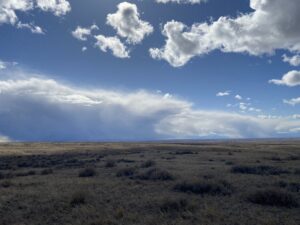
Petroleum County sits between these two rivers. It only has 496 people—the smallest population of any county in Montana. It has lived at the mercy of the commodity index. US Department of Agriculture data show that from 2012 to 2017, net farm cash income in Petroleum County dropped 63 percent. Years ago, there were twenty-four school districts in the county. Now the single remaining district faces declining enrollment. When students graduate, they tend to leave.
These aren’t new problems for the county or agriculture. In 1939, Petroleum County officials sold off 20,000 acres of land taken for non-payment of taxes. Some went for as little as fifty cents per acre. By 1941, the county still found itself with 120,000 acres of land taken from landowners who couldn’t pay their taxes.
In the northern Rockies as a whole, ranchers find themselves buried under rising costs. “We are getting a smaller piece of the food dollar. And it keeps on shrinking,” said Leo Barthelmess, who operates in Phillips County, just north of Petroleum. “Meanwhile our input costs, like insurance, equipment, and feed, keep on rising. The price of land is also climbing.”
“Life here is hard,” says Lindsey Wilkerson, superintendent of the Petroleum County schools. “Those hardships have developed some very self-reliant people.”
And sometimes embittered. It’s no accident that The Montana Freeman Movement, a militant antigovernment group that surged in the 1980s, had its roots in Garfield County, located just east of Petroleum County. The signs of a siege mentality abound in Winnett, the Petroleum County seat. Trump: No More Bullshit; Save the Cowboy: Stop the American Prairie Reserve; The Sierra Club Sucks. Each block has at least two or three abandoned and boarded-up homes. Paved streets are few.
“Hold the line? Bullshit, we’re going to create something.”
But that’s not the whole picture. Far from it. Winnett is redefining what it means to be self-reliant. It has the standard rural metrics of sufficiency: plenty of neat and well kept homes, a bar, grocery store, motel, post office, city hall, county buildings, and a K-12 school. But it also has new and restored structures, one quite imposing at nearly 12,000 square feet. Indeed, one cannot help but notice the activity, the roar of equipment and echoing of hammers, as workers erect the Petroleum County Community Center. Once completed, it will serve as a gathering place for community events like weddings, adult education classes, and receptions.
One might reasonably ask: What’s going on? How can a county with a $1.8 million total assessed valuation be building a $5 million community center? The answer is that extractive-based money funded most of this structure and county residents chipped in the rest. Native son Larry Carrell, a petroleum engineer, made his money in oil and gas. He gave back to a place with disappearing oil and gas reserves.
Oil isn’t the only commodity paying it forward. Just up the block from the construction activity sits a well worn, boarded-up structure. The Odd Fellows Hall, built in 1914, rests upon a brand new foundation. It took 245 hours of volunteers to dig, shoot grades, haul dirt, set footings and pour the concrete. The building, with much celebration, was moved from its original site on February 7, 2022.
An organization rooted in agriculture—the Winnett Agricultural Community Enhancement and Sustainability (ACES)—holds title to the Odd Fellow’s Hall. This nonprofit 501c3 has renovation in the works, including a major interior remodel. There’s discussion of a retail and coffee shop on the first floor and apartments on the second.
There’s more on ACES’s improvement docket. With the help of the Montana Historical Foundation, and others, ACES is undertaking a feasibility study for rehabilitation of the county courthouse. Commercial spaces and small apartments for new school teachers are planned for the now mostly disused upper floors.
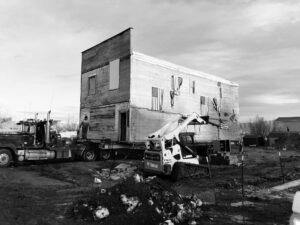
Founded in 2016, Winnett ACES understood that if the region was to thrive, agriculture had to become more inclusive and involve community affairs. The ACES Facebook page describes the organization as “a community group that works to improve land, life, and community in Winnett, MT.”
Laura Nowlin, who ranches north of Winnett with her husband, Levi, says their first meeting was ostensibly about how Petroleum County could have a more direct role in managing wildlife. “The conversation morphed into a discussion about the problem with absentee ranch owners. Then the talk centered on a more existential question: the future of Winnett,” Nowlin says.
At first, ACES undertook steps directly related to ranching, such as putting local beef in the public schools and, most ambitiously, starting a grass bank for young ranchers. A grass bank is a type of grazing cooperative where aspiring stockmen combine their herds on a shared, leased piece of ground. Grass banks attempt to solve one of the thorniest problems in ranching: cost of entry for the next generation. The baton theory of agriculture—passing your operation on to the next generation—is on its last legs. The reasons have been thoroughly documented. Among them: cost of land, cost of capital, and cost of equipment.
“We need each other to build a thriving future.”
Not so long ago, it was ranches with river access and high scenic amenities nestled next to the Rockies that commanded princely prices. Now, ranches everywhere are being purchased by non-residents for recreation and hunting, squeezing agriculture out of the market. For example, the realty firm Hall and Hall recently sold the 8,426-acre Salt Sage Coulee Ranch in Petroleum County. The asking price was $4.4 million According to the US Census, the median household income in Petroleum County is $40,000.
This meant ACES had to expand its network in the search for grazing opportunities, sometimes finding partners in unlikely places. “We got funds from the US Fish and Wildlife Foundation,” Nowlin says. “They had money on how to develop a grass bank strategy. Some of us didn’t know what that was. We hired a consultant to write a feasibility study.”
Another door opened when Bill Milton, a rancher who lives between Roundup and Winnett, introduced the possibility of grazing on the Matador Ranch. That’s in Phillips County and owned by The Nature Conservancy (TNC). Milton invited a TNC representative to lunch. “Nobody else knew he was coming,” says Nowlin. “We were all too polite to ask him to leave. So, we listened to what he had to say. The people of ACES are conservative, but they are also open-minded and willing to find solutions.”
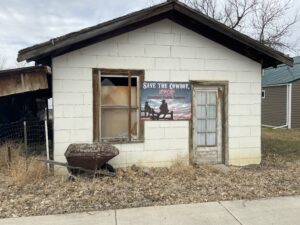
According to Milton, the meeting was met with mixed results. Some of the older attendees balked, saying the group needed to accept the fact that environmental nonprofits like TNC “just didn’t like us.”
Agriculture invests a lot of time being on the defensive: grazing on public land, use of chemicals, soil loss, trespass issues, fencing policy, and more. Milton and ACES prefer positive demonstrations. Converts to the ACES aspirations, “are no longer spending 90 percent of their time at a stock grower’s meeting defending themselves,” says Milton. “They’re not trying to hold the line. Hold the line? Bullshit, we’re going to create something. We’re going to build community centers. We’re going to put beef in the schools. We’re going to work on historic buildings. We’re going to invite people in to talk about soil. These things are well attended.”
So far, the Matador partnership has not come to pass. Yet Milton remains confident. A grass bank, he says, will happen. “It’s just a matter of time. We’ve got all the pieces in place.” And although deciding to form a grass bank is what pulled ACES together, their mission has expanded. Nowlin says “We have a lot of broader community goals, too. We’re an agricultural community but can’t survive with those who live in town. If we’re concerned about ag, we’re concerned with the town itself.”
This blurring of the distinction between town and county is relatively novel for the American West. For decades, agricultural communities gave priority to supporting farmers and ranchers. They considered it a prudent path to prosperity; more essentially it allowed residents to keep their cultural identity. Then reality required a readjustment. Market cycles proved punishing and, for many, unsustainable. Principles of efficiency and evolving technology were so ardently followed by ranching and farming that they minimized the human factor. The 1980s agriculture crisis drove the final nail in the projection that successful agriculture equaled thriving town. Since then, it’s questionable if production agriculture needs towns or any semblance of a working community to succeed.
For example, in a recent interview, Karl Stauber, former Deputy Undersecretary of Rural Development observed, “We are at a strange point in our history. The economic reality of agriculture has displaced the cultural reality of community. Education, broad-based education, is no longer necessary for a farmer to prosper. If a community loses its champion high school, how does that relate to the farmer or rancher? What farmers need to prosper, and what community needs are two different things. I think more farmers and communities haven’t realized this yet.”
Milton doesn’t think that fits the Winnett model. “There’s probably data that agree with that vision. But we have a competing vision. These self-governing, self-organizing circles have the capacity to right this huge wave of concentration. And these circles involve more than just agriculture.”
This inclusivity goes beyond Winnett. Roughly 135 miles north lies Phillips, a struggling county on the Milk River. The county seat is Malta. The population is declining and growing older. The number of ranches and farms dropped 20 percent from 2010 to 2020. Leo Barthelmess, who runs 700 mother cows south of Malta with his brother, is trying to do something about this.
Once the pivot is made, other changes often follow.
He goes to school often. Never mind that he is sixty-six years old, a fourth generation rancher who has been raising cattle and sheep since 1964. You would think he already knows what he needs to know. Yet Barthelmess is afflicted with a bad case of lifelong learning. As he puts it: “I’m a breeder and a reader. I’ve spent many a night reading about how we can be better ranchers.”
Barthelmess attends classes put on by Ranching for Profit, a Wheatland, Wyoming based company that advertises itself as “transforming ranches into sustainable businesses.” This approach dovetails with lessons Barthelmess has learned over the years from applying the principles of Holistic Management. This school has a core tenet (monitored rotational grazing) but also advocates that livestock needs to be managed as an integral part of the wider ecosystem. The longer you listen to Barthelmess, the more you realize he’s talking about more than just running cows, although they get plenty of attention.
Barthelmess is president of the Rancher’s Stewardship Alliance, based out of Malta. Its mission statement is “Ranching, Conservation, Communities—a Winning Team.” He writes in the organization’s annual report, “Our collective successes are only possible when we tap into the reserves of a deeply rooted community. We need each other to build a thriving future.”
This also means avoiding technological seclusion. Since 2019, Barthelmess and his brother have been part of a pilot project using electronic collars to move cattle. The collars, manufactured by the Vence Corporation of San Diego, permit real-time monitoring of livestock and pressure the animals, either by auditory or electronic stimulus, to move in certain direction and avoid others. If a cow approaches the edge of a grazing paddock, the collar emits a sound. If the cow continues to move towards the perimeter, she gets a shock. “It takes about two days for a cow to learn the drill,” says Barthelmess.
The use of electronic collars, if they prove viable in the long-term and at-scale, have a long list of benefits. For starters, they help efficiently and economically maintain better pasture. The ultimate goal of rotational grazing is fostering soil health; with better soil comes an abundance of better forage and, hopefully, fatter cows. Yet moving cattle frequently requires time and labor, a strike against economy. In contrast, the collars have allowed Barthelmess to manage his paddocks virtually, altering the size and placement of the pasture through the Vence Herd Manager webpage. As a result, the ranch has gone from minimal rotation to having thirty-eight or more pastures. “We move the cattle weekly or even every ten to twenty days. We’ve also been able to diversify their diet and increase stock density,” says Barthelmess.
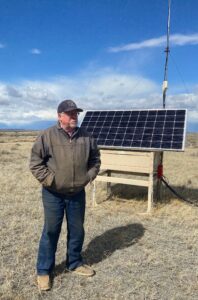
Electronic collars could also mean reduced fencing, a boon to wildlife. Barthelmess says, “we have sixty miles of barbed wire fencing. Some of it’s eighty years old. The cost to replace it is tremendous, about $15,000-20,000 per mile. We also have the second longest antelope migration in North America. Less fencing would improve their survival. We like to minimize the conflict with wildlife, plus improve our soils and grazing lands.”
Marisa Sather, a wildlife biologist with the US Fish and Wildlife Service, helped Barthelmess get a grant for the collars. She says they portend major change for ranching. “It’s really a new business model. The amount of emails and phone calls I’ve gotten inquiring about electric collars is impressive. It [development] won’t be fast and probably won’t totally eliminate boundary fencing. But it will reduce interior fencing,” she says.
This reduction in fencing, she says, spells good news for wildlife. During migrations antelope can, “hit hundreds of fences, some wildlife friendly, some not,” she said. “With each fence they might either scrape off hide and hair or spend some time running up and down the fence line looking for a place to cross. Some die trying.”
The promise of fence elimination leaves Barthelmess hopeful but far from certain. “Maybe,” he says. “But what if these collars, in the long run, don’t work? We plan to remove old fence as maintenance costs exceed value. Then it will be replaced by the newest Vence technologies.”
Barthelmess and his brother are challenging another tradition: eliminate winter feeding. The goal is to graze year around. “We haven’t done it yet but we’re working on it,” says Barthelmess. If successful, it would rewrite ranching tradition and economics. Putting up feed is expensive. “When I was a kid, we’d invest three to four hundred hours each summer cutting and putting up feed,” he said. “The value of livestock and the price of equipment has changed. It’s not sustainable for the long-term. We can’t afford to put up hay.”
To those unfamiliar with tomorrow country, these developments—Winnett’s community center, the work of ACES, the Barthelmess brothers’ willingness to experiment with electronic collars and reduced winter feed—may appear insignificant. Yet they represent the logical path for bottom-up shifts in conservative rural communities. They are what sociologist Shawn Ginwright calls “a pivot:” a small but powerful change. Once the pivot is made, other changes often follow.
Think of the situation in these counties as an earthbound version of an extended slack tide. Commodities grown by family producers have been moving away from these places for decades. In the rural Rocky Mountain West, small ranches get swallowed by larger operations. Grain elevators and houses sit empty.
The demographic data suggest, however, the tide is slowly coming back in. The 2010 and 2020 censuses show that Petroleum County actually gained population. Maybe it’s only two folks, but that means that the bleeding has slowed to a trickle. Phillips County only lost thirty-six people from 2010 to 2020, the slowest decrease in forty years.
It also shows confidence in an idea, expressed with an agricultural sense of patience. For example, after struggling to create the grass bank it deemed so critical, the Winnett ACES’s relationship-building paid off last year.
Curt and Kate Vogel, a couple from Bozeman, had a 680-acre parcel of land near Winnett. It had been in the Vogel family since 1911 and was being leased out to a neighbor. The couple decided to donate it to The Nature Conservancy, but TNC wasn’t sure it was a good fit for their land purchases. “But,” said TNC grassland conservation director, Brian Martin, “we thought it would be a perfect fit for the Winnett ACES.”
Nowlin sees this gift as the foundation for creating a grass bank. “For now, we lease the property to the neighbor because there are multiple parcels that are intermixed in a large BLM allotment. But down the road, it creates all kinds of opportunities.”
It’s this lens on the future that excites Barthlesmess. “We have so many more opportunities than I did when was I was younger. I hope the young realize the opportunities we have out here. One of the hopes of the collar is that it will engage the next generation.”
And don’t forget fun. “We enjoy the work with ACES,” says Nowlin. “It’s a social thing. It’s energizing. It’s energizing to have people appreciate the work. We go to the bars but instead of complaining, we celebrate we’re solving some of the world’s problems.”
Samuel Western has covered Rocky Mountain natural resource issues for decades. For twenty-five years he was a correspondent for The Economist in London. His next book, A Reckoning in August, explores the political and economic shifts of the Great Plains and Northern Rockies from statehood to the current era.


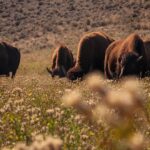
Pingback: Editor’s Note – Western Confluence